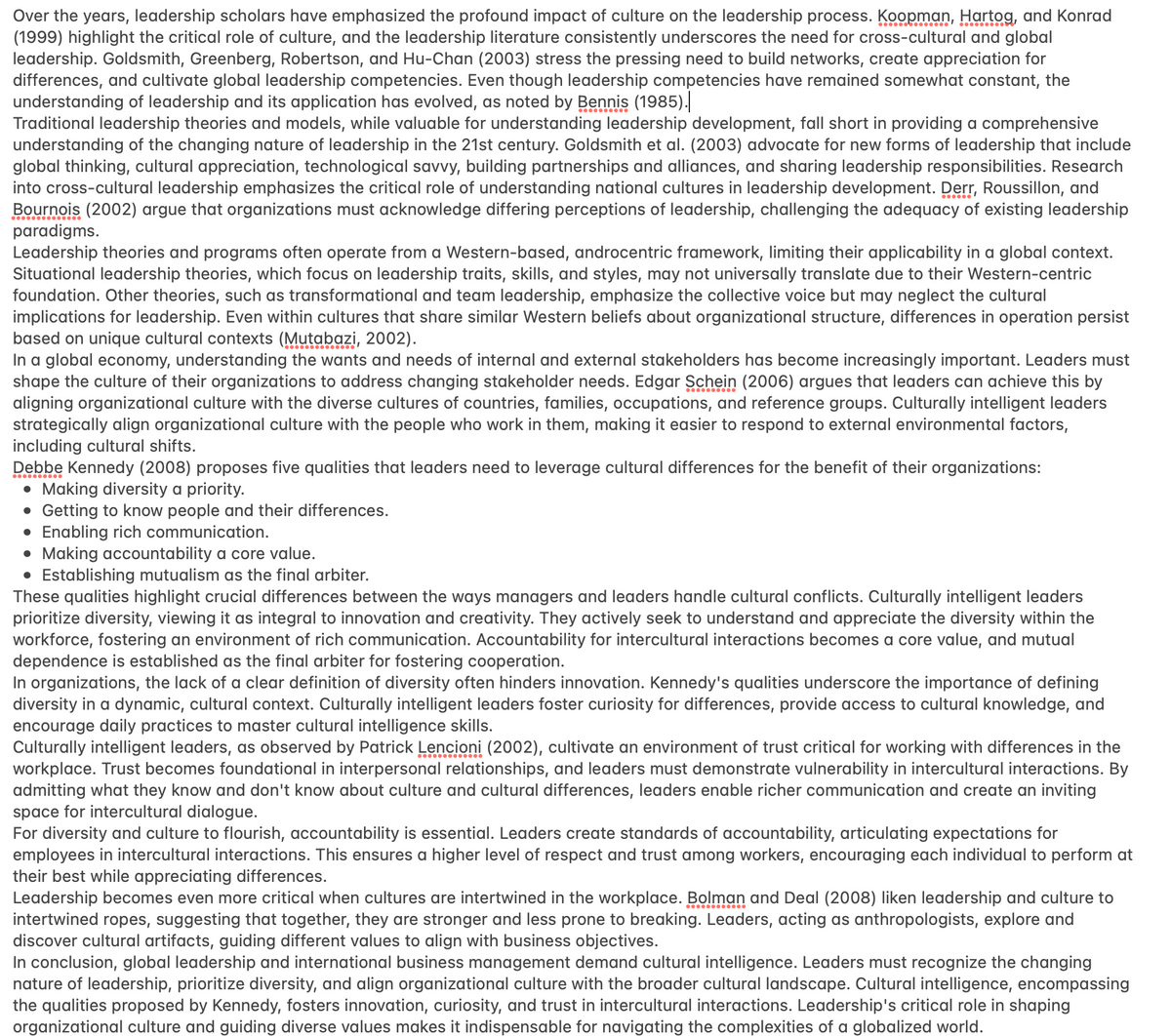Management, Loose-Leaf Version
13th Edition
ISBN:9781305969308
Author:Richard L. Daft
Publisher:Richard L. Daft
Chapter15: Leadership
Section: Chapter Questions
Problem 2EE
Related questions
Question
Can you please tell me if this describes global leadership and business managment from a cultural persepctive?

Transcribed Image Text:Over the years, leadership scholars have emphasized the profound impact of culture on the leadership process. Koopman, Hartog, and Konrad
(1999) highlight the critical role of culture, and the leadership literature consistently underscores the need for cross-cultural and global
leadership. Goldsmith, Greenberg, Robertson, and Hu-Chan (2003) stress the pressing need to build networks, create appreciation for
differences, and cultivate global leadership competencies. Even though leadership competencies have remained somewhat constant, the
understanding of leadership and its application has evolved, as noted by Bennis (1985).
Traditional leadership theories and models, while valuable for understanding leadership development, fall short in providing a comprehensive
understanding of the changing nature of leadership in the 21st century. Goldsmith et al. (2003) advocate for new forms of leadership that include
global thinking, cultural appreciation, technological savvy, building partnerships and alliances, and sharing leadership responsibilities. Research
into cross-cultural leadership emphasizes the critical role of understanding national cultures in leadership development. Derr, Roussillon, and
Bournois (2002) argue that organizations must acknowledge differing perceptions of leadership, challenging the adequacy of existing leadership
paradigms.
Leadership theories and programs often operate from a Western-based, androcentric framework, limiting their applicability in a global context.
Situational leadership theories, which focus on leadership traits, skills, and styles, may not universally translate due to their Western-centric
foundation. Other theories, such as transformational and team leadership, emphasize the collective voice but may neglect the cultural
implications for leadership. Even within cultures that share similar Western beliefs about organizational structure, differences in operation persist
based on unique cultural contexts (Mutabazi, 2002).
In a global economy, understanding the wants and needs of internal and external stakeholders has become increasingly important. Leaders must
shape the culture of their organizations to address changing stakeholder needs. Edgar Schein (2006) argues that leaders can achieve this by
aligning organizational culture with the diverse cultures of countries, families, occupations, and reference groups. Culturally intelligent leaders
strategically align organizational culture with the people who work in them, making it easier to respond to external environmental factors,
including cultural shifts.
Debbe Kennedy (2008) proposes five qualities that leaders need to leverage cultural differences for the benefit of their organizations:
● Making diversity a priority.
• Getting to know people and their differences.
● Enabling rich communication.
• Making accountability a core value.
• Establishing mutualism as the final arbiter.
These qualities highlight crucial differences between the ways managers and leaders handle cultural conflicts. Culturally intelligent leaders
prioritize diversity, viewing it as integral to innovation and creativity. They actively seek to understand and appreciate the diversity within the
workforce, fostering an environment of rich communication. Accountability for intercultural interactions becomes a core value, and mutual
dependence is established as the final arbiter for fostering cooperation.
In organizations, the lack of a clear definition of diversity often hinders innovation. Kennedy's qualities underscore the importance of defining
diversity in a dynamic, cultural context. Culturally intelligent leaders foster curiosity for differences, provide access to cultural knowledge, and
encourage daily practices to master cultural intelligence skills.
Culturally intelligent leaders, as observed by Patrick Lencioni (2002), cultivate an environment of trust critical for working with differences in the
workplace. Trust becomes foundational in interpersonal relationships, and leaders must demonstrate vulnerability in intercultural interactions. By
admitting what they know and don't know about culture and cultural differences, leaders enable richer communication and create an inviting
space for intercultural dialogue.
For diversity and culture to flourish, accountability is essential. Leaders create standards of accountability, articulating expectations for
employees in intercultural interactions. This ensures a higher level of respect and trust among workers, encouraging each individual to perform at
their best while appreciating differences.
Leadership becomes even more critical when cultures are intertwined in the workplace. Bolman and Deal (2008) liken leadership and culture to
intertwined ropes, suggesting that together, they are stronger and less prone to breaking. Leaders, acting as anthropologists, explore and
discover cultural artifacts, guiding different values to align with business objectives.
In conclusion, global leadership and international business management demand cultural intelligence. Leaders must recognize the changing
nature of leadership, prioritize diversity, and align organizational culture with the broader cultural landscape. Cultural intelligence, encompassing
the qualities proposed by Kennedy, fosters innovation, curiosity, and trust in intercultural interactions. Leadership's critical role in shaping
organizational culture and guiding diverse values makes it indispensable for navigating the complexities of a globalized world.
Expert Solution
This question has been solved!
Explore an expertly crafted, step-by-step solution for a thorough understanding of key concepts.
Step by step
Solved in 3 steps

Recommended textbooks for you

Management, Loose-Leaf Version
Management
ISBN:
9781305969308
Author:
Richard L. Daft
Publisher:
South-Western College Pub

Understanding Management (MindTap Course List)
Management
ISBN:
9781305502215
Author:
Richard L. Daft, Dorothy Marcic
Publisher:
Cengage Learning


Management, Loose-Leaf Version
Management
ISBN:
9781305969308
Author:
Richard L. Daft
Publisher:
South-Western College Pub

Understanding Management (MindTap Course List)
Management
ISBN:
9781305502215
Author:
Richard L. Daft, Dorothy Marcic
Publisher:
Cengage Learning
